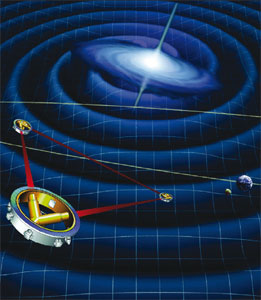“In the beginning was the Word,” opens the gospel of John, and this finds some resonance in the possibility of detecting gravitational waves from the Big Bang itself at frequencies typical of sound waves. Careful listening to this background signal would probe the inflation phase of the very early universe.

Astronomy is a science based on photons. First limited to visible light and then broadening to include radio waves, the field of investigation has exploded during recent decades. Windows on the sky at new wavelengths have opened one by one thanks to the use of satellites to avoid absorption by the Earth’s atmosphere. However, at any wavelength, the quest towards the beginning of time stops abruptly 380,000 years after the Big Bang, when the emission of the cosmic microwave background (CMB) occurred. This is when the universe became transparent and there is no hope of looking further back in time via electromagnetic radiation. Although earlier events like inflation may leave some imprint in the map of the CMB (see CERN Courier May 2006 p12), a direct messenger from the very early universe must be of a different nature.
Primordial neutrinos from the time of Big Bang nucleosynthesis would be a good candidate for such a messenger, but their very low energy and interaction cross-section makes them currently undetectable. Gravitational waves are another candidate attracting a great deal of interest as a possible witness of the very early universe. Einstein’s general theory of relativity predicts that these distortions of space–time propagate with the speed of light. Although studying the change of period of tight double-pulsar systems has demonstrated their existence (see CERN Courier March 2004 p12), direct detection is still to be achieved despite the great effort invested to detect these subtle disturbances of space–time.
A theoretical study by Juan Garcia-Bellido and Daniel Figueroa from the Universidad Autonoma de Madrid, Spain, sheds a new light on the expected amplitude and spectral property of primordial gravitational waves. The study focuses on the violent reheating of the universe after hybrid inflation. According to the researchers, many extensions of the Standard Model of particle physics expect this process, both in string and supersymmetric theories.
They suggest that such a process would lead to the formation of high-energy bubble-like structures, which would collide and generate a stochastic background of gravitational waves. Taking into account the expected downshift of this radiation by 24 orders of magnitude due to the cosmic expansion since that time, their calculation predicts a maximum intensity of gravitational waves at frequencies from about 1 Hz for a low-scale inflation model up to about 10 MHz for a high-scale model.
This frequency range is too high to be accessible to the future Laser Interferometer Space Antenna (LISA), a joint mission of ESA and NASA, but there is hope to detect the expected signal with other projects, on the ground with the Advanced Laser Interferometer Gravitational Wave Observatory or in space with NASA’s proposed Big Bang Observer. There is no doubt that the detection of gravitational waves from the first 10-34 s of the universe would be a new milestone in science, allowing physicists to confront their models with observations.
Further reading
J Garcia-Bellido and D G Figueroa 2007 Phys. Rev. Lett. in press [See also http://arxiv.org/abs/astro-ph/0701014].







